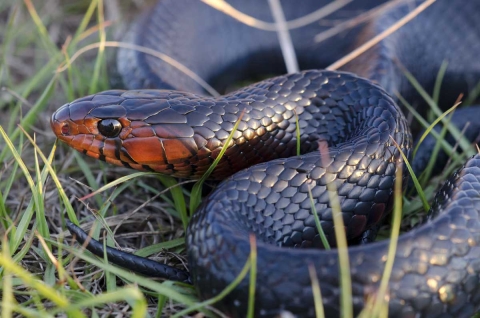About Us
The U.S. Fish and Wildlife Service established Everglades Headwaters National Wildlife Refuge and Conservation Area on January 18, 2012, making it the 556th refuge in the country. The Refuge currently includes approximately 3,854 acres of lands. The refuge serves as an important site for the recovery of federal and state listed threatened and endangered species. The Refuge’s location and habitat features are important for the future of over 10 Federally listed species, including Eastern indigo snake (Drymarchon carais couperi), sand skink (Neoseps reynoldsi), Florida ziziphus (Ziziphus celata), pygmy fringe-tree (Chionanthus pygmaeus), sand pine whitlow‐wort (Paronychia chartacea), scrub beargrass (Nolina brittoniana), and scrub blazing star (Liatris ohlingerae).
Our Mission
The refuge and Conservation Area were established to help:
- Protect, restore and conserve important habitat for 88 federal and state listed species and state Species of Greatest Conservation Need (SGCN), including Florida panther, Florida black bear, Audubon’s crested caracara, Florida scrub jay, Florida grasshopper sparrow, red-cockaded woodpecker, whooping crane, Everglades snail kite, wood stork, and Eastern indigo snake (learn more about these animals on the Benefits to Wildlife page)
- Protect, restore, and conserve exemplary habitats such as wet and dry prairie, Florida sandhill and scrub, scrubby and mesic flatwoods, and multiple wetland types including cutthroat seepage slope wetlands;
- Protect, restore, and conserve the headwaters, groundwater recharge and watershed of the Kissimmee Chain of Lakes, Kissimmee River and Lake Okeechobee region, which will improve water quantity and quality in the Everglades watershed, complementing the work of the Comprehensive Everglades Restoration Plan (CERP), and protecting the water supply for millions of people;
- Protect and enhance habitat corridors and implement other wildlife adaptation strategies to buffer the impacts of climate change climate change
Climate change includes both global warming driven by human-induced emissions of greenhouse gases and the resulting large-scale shifts in weather patterns. Though there have been previous periods of climatic change, since the mid-20th century humans have had an unprecedented impact on Earth's climate system and caused change on a global scale.
Learn more about climate change ; and - Protect a working rural landscape, where local communities, ranching and agricultural interests, the Service, and its partners would conserve natural resources and provide opportunities for compatible outdoor recreation and educational opportunities, while preserving the economic and cultural benefits provided by ranching.
Other Facilities in this Complex
Everglades Headwaters National Wildlife Refuge is managed as part of the Everglades Headwaters National Wildlife Refuge Complex.

